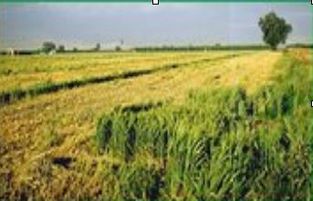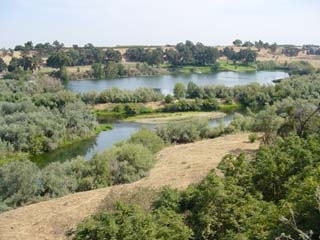Granitic Alluvial Fans and Terraces
| Topics: |
Geology (main)
|
 Alluvial fan area, San Joaquin Valley. The Granitic Alluvial Fans and Terraces subsection is on alluvial fans that are below older fans or terraces on the east side of the San Joaquin Valley of California; the San Joaquin Valley is that part of the California Central Valley south of the join of the Sacramento and San Joaquin Rivers. The climate is hot and subhumid. The subsection is given the designation MLRA 17f.
Alluvial fan area, San Joaquin Valley. The Granitic Alluvial Fans and Terraces subsection is on alluvial fans that are below older fans or terraces on the east side of the San Joaquin Valley of California; the San Joaquin Valley is that part of the California Central Valley south of the join of the Sacramento and San Joaquin Rivers. The climate is hot and subhumid. The subsection is given the designation MLRA 17f.
Contents
Lithology and Stratigraphy
This subsection contains late Quaternary alluvium. The alluvium is predominantly from granitic rock sources in the southern Sierra Nevada.
Geomorphology
This subsection is nearly level to very gently sloping alluvial fans and basins. There are small areas of floodplain along streams that cross from mountains of the Sierra Nevada to reach basins in the San Joaquin Valley of California. The subsection elevation range is from 150 to about 400 feet. Fluvial erosion and deposition are the main geomorphic processes.
The San Joaquin Valley itself began to form around 65,000,000 years before present, during the early Paleocene era. Wide sea level fluctuations led to seawater inundation for various areas of the valleyduring the ensuing 60,000,000 years. Then, approximately 5,000,000 years ago, the marine outlets began to close due to uplift of the coastal ranges and the deposition of sediment in the valley.
Soils
The soils are Typic Xerofluvents, Typic Xerorthents, Typic Xeropsamments, Haploxerolls, Entic Durochrepts, Typic and Natric Haploxeralfs, Typic and Aquic Natrixeralfs, Natric Durixeralfs, and Typic and Aeric Haplaquepts. The Haploxerolls are in Fluventic, Entic, Cumulic, and Aquic subgroups. Also, there are Typic Endoaquepts, Fluvaquentic Endoaquolls, and Sodic Endoaquerts in basin-fill at the toes of the alluvial fans. The soils are mostly well drained on the fans to poorly drained in the basins. Bicarbonate weathering and leaching and accumulation of clay and silica in subsoils are the main pedogenic processes in the terrace soils. Calcium carbonates accumulate in some of the soils, and sodium accumulates in soils with poor drainage or slowly permeable subsoils. The soil temperature regimes are thermic. Soil moisture regimes are xeric and aquic.
Vegetation
The predominant natural plant communities are Needlegrass grasslands and Valley oak series on alluvial fans, Fremont cottonwood series along some streams, Emergent aquatic communities in basins, and Allscale series around the margins of basins.
Characteristic series by lifeform include:
Climate
The mean annual precipitation is about eight to twelve inches; it is practically all in the form of rain. Mean annual temperature is about 59° to 62° F. The mean freeze-free period is about 250 to 300 days.
Surface Water
Streams in this subsection drain to basins at the toes of the alluvial fans. Those on the north side of the Kings River fan drain to the San Joaquin River and those on the south side of the fan drain to the Tulare Basin. Streams in the basin draining to the San Joaquin River are parallel to the axis of the Central Valley, perpendicular to those on the fans. All but the larger streams are generally dry during the summer. There are no permanent lakes.
References
- Robert F.Heizer and Albert B.Elsasser. 1980. The Natural World of the California Indians. Berkeley: University of California Press. ISBN9780520038967.
- United States Forest Service. "Sierra Nevada". Ecological Subregions of California.

